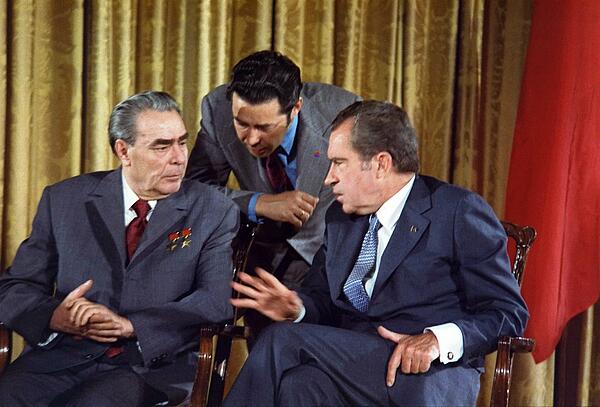Detente
The Détente was a permanent relaxation or ‘thaw’ in international tensions which commenced in 1969 and lasted until 1980 with the Soviet invasion of Afghanistan.
Why did the 1970s witness a detente? There were two main reasons. First, the horrors of the Vietnam War sent shockwaves around the world. Second, there was a growing fear of a nuclear destruction, especially as the number of countries that had nuclear weapons grew. Through the Cold War arms race the US and USSR had developed and built a huge number of extraordinarily dangerous weapons.

Why did three major powers want to pursue detente?
China
China’s main fear was to become isolated from the rest of the world. Chinese rulers had seen what happened in Vietnam, and did not want a similar conflict in China. The Asian country had a much smaller supply of nuclear weapons than the US while relations with the USSR were also deteriorating, which meant China could easily be cut adrift from both sides.
US
Led by Presidents Nixon and Ford, America wanted to find better ways of controlling and oppressing communism that its previous approach. The country had also begun to feel the considerable financial strain of amassing a huge stockpile of nuclear weapons and also maintaining a large army - this became particularly pertinent following the costly Vietnam War, which drove it to reassess its relationship with the USSR.
USSR
Like the USA, the USSR had found itself spending vast amounts of money on developing and building new weapons - this came at the expense of its population's living standards as the price of everyday goods began to rise. Like China, there were also fears that if it did not strengthen its relationship with the Asian power then it would be exposed in a war against the US.
How did the world's major powers attempt to ease world tension?
USSR and US:
1963: The Moscow-Washington hotline was established in the wake of the Cuban Missile Crisis. In the same year, both sides agreed that they would only carry out nuclear explosions underground.
1969: Strategic Arms Limitation Talks (SALT) start, which as the name suggests aimed to limit each country’s military clout.
1972: American President Richard Nixon visited the capital of the USSR: Moscow.
1973: In a reversal, the USSR’s leader Leonid Brezhnev made a diplomatic trip to the USA, visiting Washington DC.
1974: President Nixon once again visited Moscow.
1975: The USA, USSR, Canada and other major European powers all sign The Helsinki Declaration, which reaffirmed the new European boundaries that had been agreed upon at the end of World War Two.
China and USA:
The USA and China had been on poor terms since the end of WWII. First the USA supported the Chinese Nationalists in Taiwan following their fall in 1949. The country also fought against Communist China’s forces during the Korean War, albeit under the banner of the UN. However, during the 1970s relations between the two countries warmed. In 1971, the first steps to build a better relationship began as China invited the American table tennis team to come and play a match in China - this is where the term "ping—pong" diplomacy originates. In response the USA changed her stance and supported China’s entry into the UN, something it had previously stood against.
With America’s backing, China entered the UN in October 1971. To continue building relations, two US Presidents - Nixon and Ford - went on diplomatic visits to the Asian country. However, it is worth noting that the USA did maintain a sizeable naval fleet near Taiwan.
The USSR and China:
Although both communist nations, relations between the USSR and China were not particularly healthy during the 1950s - this was largely down to their ideological differences. Both nations stated that the other was guilty of "revisionism": the move away from pure communism. Territorial squabbles made matters worse; China continued to push for the land that the USSR had taken from it during the 19th century to be returned. Both countries started to compete with each over the strength of their relationship with America. This motivated both Communist states to cultivate better relations with the West.
MLA Citation/Reference
"Detente". HistoryLearning.com. 2026. Web.
